Tähtitieteellinen yhdistys Ursa
Ilmakehän optiset ilmiöt

Displays
21.4.
The big day for Finns. The persons responsible were the Savukoski gang. Claudia gives an analysis that, this happened in midst of fighting between both northern fronts moving to North-Eastern Finland. In the north, large cirrus-fields occurred, with very brilliant ice crystals. Hence a gorcious, major pyramidal display brought a great variety of odd radius rings and rare pyramidal arcs at the extreme North halo watch post of Europe. The observing reports by all three:
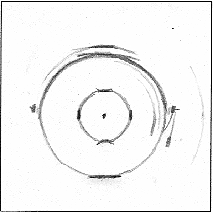
AIKIONIEMI: " ...after 10 a clock a brilliant, grey upper cloud area approached in the vicinity of horizon... again I was in school! Luck amidst the accident; the next our was that of sport exercise and conveniently we had skiing on the ice of Kemijoki river... By hurrying... a half an hour to visit home...Ilkka had not yet gone to school to Kemijärvi and I decide to go tell him that there is hard stuff on the move... I fetch Ilkka...I get camera and off we go to a field. I grasp there is something above the 22° upper tangent arc. I shout to Ilkka 'Parry!'...put a hand in front of the sun. There is smoke coming out of my eye hole. 'Oh hell, look a mind-blowing 9° halo and a lower 9° parroid! in the same instant ...you can forget the Parry, its not a Parry, but a superb 23° parroid that had had the intention to piss the observer."
HELENIUS: "...begin about 1100... At that stage I wouldn't have believed what would follow. Clock being something like 1145 Simo came over announcing 'hell of a bright 22° deg and 22° upper'. We went to field look if there's any better... 'Bright parroid! Look! 9° parroid' shouted Simo... 9° tangent arcs. The approximately 22° looked to me like one big mess as there was 20°, 23° and 24° in the sky as well. The 24° lower lateral arc appears also, which is a rarity. I notice something coming down from sun dogs. Lowitz arcs! Clock is something like 1205 when I notice something about 35° from the sun, a dim, but visible. This can't be. This halo hasn't been seen by many in Finland. Will I be one of them will be revealed from the photographs. ...The display collapsed around 1220, when lower clouds were pushed into the sky. This was the best multihalo display of my life. 15 halo forms simultaneously, over the day about 20."
PALOJÄRVI: "Conveniently I got sick in a slight fever, because in school it would have been really unpleasant to observe this kind of halos, with which one has to wave with hands like a traffic cop. Throughout the morning a watched from window at the upper cloud bank, that was approaching from the South, that looked really promising, until I noticed that thin fibres had appeared in the sun vicinity as if from nothing. I hurried outside and took the sun glasses, because I doubted there would be pyramidal halos... I started to look for the 9° halo and it immediately was caught. it appeared first as a full ring, then the left part disappeared...simultaneously a 9° lower parroid developed and an odd brightening appeared on the sides of the 9° halo... clear upper and lower Lowitz arcs... Parry or a 23° parroid... then ...the real rarity, the piece of the 35° halo, the Feuill‚e halo. ...The greatest pyramidal display I have yet experienced."
Central Europe received the front's messengers in the form of high clouds. In the Netherlands and Northern Germany quite a lot of ordinary activity was observed. In Zwolle Stefan Jak was greeted by a magnificent 22° parhelion accompanied by a likewise plate crystal population derived gorcious circumzenithal arc, "very clear and colourful!". The parhelia went in intensity to the level of exhibiting 5° vertical height. Stefan had probably the best display in Central Europe on 21st. The brilliancy of plate crystals was stretched even on the other side of the southern border for in Gent Thierry Smulders and Jürgen Buelens admired solitary sun dog displays.
Satellite image: Apr 21, 11:33+13:13 GMT
21./22.4.
Jürgen Rendtel captures a nocturnal halo interestingly as late as 0350 local time (the odd clock time lets us assume Jürgen was hunting meteors, which may perhaps not be such a preposterous claim since Rendtel is the president of IMO, the International Meteor Organization). A lunar pillar three degrees above and two degrees below the moon appears in the skies of Potsdam. Earlier at night Ludger Ihlendorf captured also a short pillar at Damme, Germany.
Also our halo watch post in Austria joins into the lunar hunt with 22° halo. Observer Karl Kaiser, Schlägl.
22.4.
The Atlantic low pressure got the better of Finland. The north was crossed by a warm front whose leading edge was fringed by halos. An occlusion over Southern Finland gave rain there. Across Central Europe spread a high pressure area. High-cloud only existed above Eastern Germany and Northern Austria. In Germany a few observers saw low activity displays.
The absolute highlight of the day is Claudia Hetze's treasure found in the Chemnitz skies in Germany. Two concentric elliptical halos manifest themselves. Sizes were 5°/2° (vert./horiz.) and 2-3°/1°. Altocumulus virga was found at the scene of the event and found guilty as evident in Claudia's drawing. Well done. Elliptical halos are still present in the Central European air space. It just needs a highly vigilant observer who knows what to look for: Ac virga or Sc virga stripes or similar narrow cloud banks drifting for few seconds or minutes to the right place in the sky.
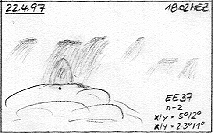
Satellite image: Apr 22, 13:02 GMT
22./23.4.
Germans continue with lunar halo capturing of earlier night. In drawings by Wolfgang Hinz one can well see how the pillar was attached to middle level clouds that occasionally blocked the moon itself and the pillar then stretched either only upwards or only downwards. Hetze and Hinz both ascribe the crystals to Altocumulus virga. Bretschneider and Klatt saw lunar pillars as well, the latter during the morning nocturnal hours.
This time both the Belgians and the British join to lunar scenarios: Alastair McBeath notices a lunar pillar in the evening hours at Morpeth, United Kingdom and in Belgium Thierry Smulders is again on halo hunt, for he reports 22° halo around the moon.
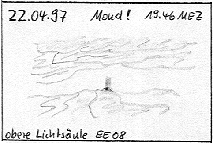
23.4.
The low pressure reached Finland, and sent a warm front with a following cold front above the land. In advance of the warm front came a single formation of halos in Central and Northern Finland. Meanwhile, the trough of a British low pressure area came to the north of Central Europe, bringing rich halo forms to the Netherlands and Northern Germany.
Frank Nieuwenhuys made a good identification in The Hague, the Netherlands by separating a straight, colourfully piece at 46° distance as a 46° supralateral arc. Indeed it is at these solar elevations that this arc appears laterally, i.e.,on the sides. Great Britain and Belgium too enjoyed halos as a warm front advanced.
Germany takes the best stuff. In Pirna Holger Lau draws an excitingly sharply curved auxiliary arc above the almost equally sharp 22° upper tangent arc. Possibly a standard Parry arc, but a beauty at any rate. The European picture is yet overwhelmingly won by Heino Bardenhagen with a collection of marvellous photographs that record superbly bright pieces of Wegener's anthelic arcs. The intensity of these pieces is incredible in any scale, even comparable to that of a coastal Antarctic station, (but naturally not comparable to the Wegener's of the interior of Antarctica). The cloud over Bardenhagen's location Helvesiek has been really interesting, but unfortunately consisted of only limited cloud banks of oddly rich material. Heino's achievements include the equally photographed 120° parhelion, bright and displaying hints of colours as rarely is the case. One of the photographs is reproduced in the color page. The print can not convey the true-on-the-field brightness of these normally extremely faint reflection halos. Furthermore the slicy appearing of rare halos in different parts of the sky adds to the difficulty of grasping this display's extraordinary quality.
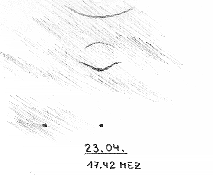
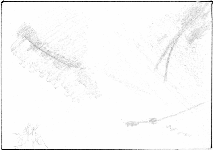
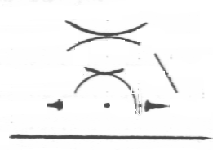
Satellite image: Apr 23, 12:52 GMT
24.4.
'The "Finnish" low disappeared to Russia, but the centre of the British low moved across to the Polish Baltic Sea, sending the forerunner of its warm front to Finland. The following cold front of this low lay before Central Europe and gave there high clouds. On this day, Mika Sillanpää was surprised by a five minute occurrence of a Parry arc in a minor display. "Sofar best in April ...Even a slightly more inexperienced observer would have seen exactly as much as nothing in the sky. Is it from this date that the SPRING starts...?" A bunch of observations came from Germany and Netherlands also from this date. Hartmut Bretschneider saw another parhelion in Schneeberg and Menno van der Haven reported about parhelia in Waddingsveen.
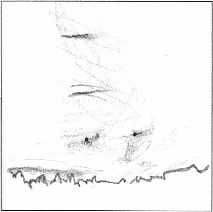
Satellite image: Apr 24, 12:41 GMT
24./25.4.
Claudia Hetze reports a lunar 22° halo in Chemnitz, Germany. Gerald Berthold raises the stakes by seeing the same as well as a moon pillar and mock moon (lunar parhelion).
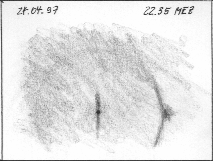
25.4.
The weather in Central Europe was influenced by several troughs, whose high clouds lay about the Netherlands and Germany, but which especially covered the south with lower clouds. Dieter Klatt witnessed a display among the very top ones in April, and probably of the whole year. The skies over Oldenburg got inspired enough to reveal Wegener's anthelic arcs, and such ones as to have a practically full development above the parhelic circle! These are one of the longest Wegener arcs on record in Central Europe and presumably the longest since the end of 1980's. Also Netherlands got part of the halo power on many locations. Check the jewel of Klatt from the drawing. It is a celestial sight to envy at any latitude in Europe. Less than half a dozen such developments of Wegener arcs have been seen during the entire life span of little less than 20 years of the FHON network in Finland. Finland was situated between an Atlantic high pressure and a North Russian low. Mid and North Finland lay under high cirrus haze, while in the south, the Sun shone unhindered. Jarmo Moilanen reported a 120° parhelion and a one-sided 46° infralateral arc. Few hundred kilometres north from Oulunsalo and 3 hours later we find Savukoski in action: the 120° parhelion has appeared also, but this time with a parhelic circle, Parry arc and coincidentally a faint piece of the Wegener's anthelic arcs, nothing to compare with Klatt's one. An anthelion is visible as a brightening opposite the sun. "A dazzlingly bright 22° upper tangent arc."
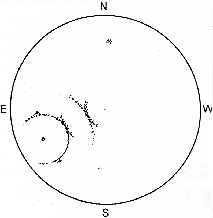
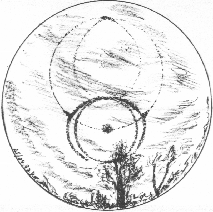
Satellite image: Apr 25, 12:30 GMT
European Halo Project | Contents | Previous chapter | Next chapter
-
 Useita halomuotoja II 2.1.2026 klo 20.34; Nivala; Heli Ojalehto
Useita halomuotoja II 2.1.2026 klo 20.34; Nivala; Heli Ojalehto -
 Harvinaisia halomuotoja IV 2.1.2026 klo 19.00; Oulu; Marja Marttila
Harvinaisia halomuotoja IV 2.1.2026 klo 19.00; Oulu; Marja Marttila -
 Useita halomuotoja II 2.1.2026 klo 19.00; Raahe; Irina Jylhä
Useita halomuotoja II 2.1.2026 klo 19.00; Raahe; Irina Jylhä -
 Yksi halomuoto I 2.1.2026 klo 18.00-18.01; Haapavesi; Osmo Hyvärinen
Yksi halomuoto I 2.1.2026 klo 18.00-18.01; Haapavesi; Osmo Hyvärinen -
 Useita halomuotoja II 2.1.2026 klo 13.00-13.10; Kajaani; Mervi Juntunen
Useita halomuotoja II 2.1.2026 klo 13.00-13.10; Kajaani; Mervi Juntunen -
 Useita halomuotoja II 2.1.2026 klo 12.30-14.00; Raahe; Mikko Silvola
Useita halomuotoja II 2.1.2026 klo 12.30-14.00; Raahe; Mikko Silvola -
 Useita halomuotoja II 2.1.2026 klo 11.00-14.00; Raahe; Irina Jylhä
Useita halomuotoja II 2.1.2026 klo 11.00-14.00; Raahe; Irina Jylhä -
 Keinovalopilareita II 2.1.2026 klo 2.00-3.00; Kempele; Marko Haapala
Keinovalopilareita II 2.1.2026 klo 2.00-3.00; Kempele; Marko Haapala
-
 Yksi halomuoto I 2.1.2026 klo 0.27; Parkano; Soili Jalava
Yksi halomuoto I 2.1.2026 klo 0.27; Parkano; Soili Jalava -
 Harvinaisia halomuotoja IV 2.1.2026 klo 0.25-4.10; Vaasa; Timo Alanko
Harvinaisia halomuotoja IV 2.1.2026 klo 0.25-4.10; Vaasa; Timo Alanko -
 Yksi halomuoto I 2.1.2026 klo 0.05-0.15; Kauhajoki; Anu Kilpiö
Yksi halomuoto I 2.1.2026 klo 0.05-0.15; Kauhajoki; Anu Kilpiö -
 Useita halomuotoja II 1.1.2026 klo 22.50-23.30; Seinäjoki; Pekka Lähteenmäki
Useita halomuotoja II 1.1.2026 klo 22.50-23.30; Seinäjoki; Pekka Lähteenmäki -
 Keinovalopilareita 1.1.2026 klo 22.00-22.30; Oulu; Ari Juntunen
Keinovalopilareita 1.1.2026 klo 22.00-22.30; Oulu; Ari Juntunen
-
 Useita halomuotoja II 1.1.2026 klo 22.00 - 2.1.2026 klo 7.00; Vaasa; Juha Varis
Useita halomuotoja II 1.1.2026 klo 22.00 - 2.1.2026 klo 7.00; Vaasa; Juha Varis -
 Yksi halomuoto I 1.1.2026 klo 21.47; Simo; Joni Alavesa
Yksi halomuoto I 1.1.2026 klo 21.47; Simo; Joni Alavesa
![[EHP]](fileadmin/_migrated/RTE/RTEmagicC_664970cc8d.gif.gif)
